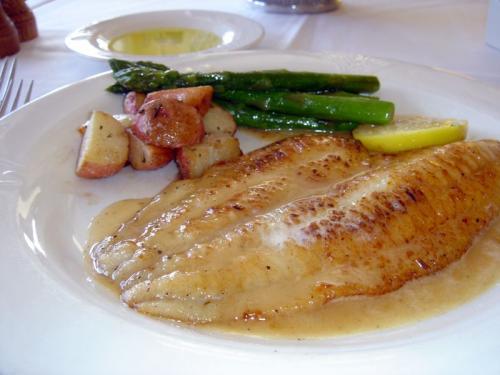How to make whole sauteed Dover sole
Cooking whole fish in a pan, in butter, is a wonderful way of encouraging a crisp, buttery exterior and a perfectly moist interior. And it just doesn’t get any better than doing it with whole Dover sole, especially when it’s just come in fresh from Holland. Each fish is under a pound after cleaning and removing the black skin on the upper side, so one Dover sole makes a perfect portion for one person. This is a preparation that’s so simple it may seem boring. But try it just once so you can see why this classic is irrefutably timeless! Serves 2.

Things you’ll need
- sharp French knife
- kitchen shears
- small sauce pan
- sauté pan big enough for both fish
- 3 large platters
- wide metal spatula
- 2 Dover soles, fresh, gutted
- 2 tbsp. milk
- salt and pepper to taste
- flour for coating (about 2 cups)
- 1 stick (½ cup) plus 2 tbsp. unsalted butter
- chopped fresh parsley for garnish
- lemon wedges for garnish
Procedure Steps
- To remove the black skin on the top side of the fish, cut off the dorsal fins and anal fins with shears. Then, with the dark side up and holding the tail in one hand, make a small incision just above the tail with the knife. Cut a small flap of the skin at that point, just enough to grab the skin with your hand. Then pull the skin in the direction of the head, pulling the skin away from the flesh. The dark skin should come off easily. The other side of the fish does not need to have the skin removed.
- Place both pieces of fish on a platter and sprinkle the milk all over each one. Season well with salt and pepper. Place a bed of flour on a second platter, and put one of the soles in the flour. Turn several times to coat, then shake off any excess flour and lay it on the third platter. Repeat the same process for the second sole. Dry both for 10 minutes.
- Put the stick of butter in the small sauce pan over a medium heat. As soon as the butter has melted, skim off and throw away the foam on top. Then pour the butter in one motion into a small dish, leaving behind the milky solids at the bottom of the pan. The clear liquid in the small dish is clarified butter.
- Put the clarified butter into the sauté pan over a medium-high heat. If you don’t have a pan large enough to cook both of the fish at the same time, then divide the clarified butter in half to use for each piece. As soon as the butter is very hot, but before it starts smoking in the pan, add the fish skin side up.
- After about 1 minute or so, slide the spatula under to make sure the fish is not sticking. After a total of 3 minutes, check the underside; it should be golden brown. If it is, carefully turn the fish onto its other side. Cook another 3 minutes, or until the underside is golden brown. Remove the Dover sole and place it on a serving plate.
- Remove the pan from the heat, and wipe out most of the clarified butter with a paper towel. Quickly toss the remaining 2 tbsp. of butter into the pan. Within a few seconds, it should be melted and foamy. Immediately pour it over the cooked fish. Top with the chopped parsley. Place the lemon wedges on the side and serve immediately.
Tips
- If you have access to a fishmonger or butcher at your grocery store or market, they can remove the skin for little or no cost.
- Always wash the fish under cold water and pat it dry with a towel before beginning to prepare it.
- Never freeze the fish unless absolutely necessary because the quality will never be as good as when it is fresh.
- Serve with a side of boiled potatoes, or just a crisp glass of white wine.
Warnings
- Be sure to purchase only the freshest fish possible. It should have bright clean eyes, not cloudy or dry. The fish itself should smell like the ocean air only, not sour or pungent. The flesh should be firm and spring back when pressed.
- Cook the fish as soon as possible after purchasing it. Keep it wrapped in the refrigerator for no more that 2 to 3 days.
- Always wash down the cutting board and working surfaces of your kitchen with a dilution of hot water and a little bleach when you’re finished preparing the fish.

What did you think of this tutorial?
+ 5
0 CommentsAdd a Comment




